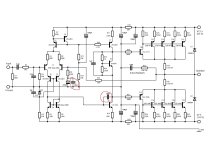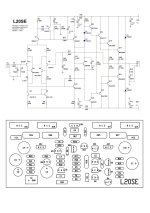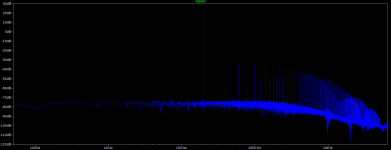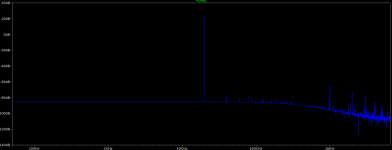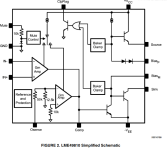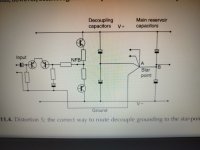Have you noticed the purpose of LJMs' participation here: strictly to maintain the sales of his amplifiers. He refuses to respond to technical questions even though he, as a designer should. I have reported here a serious flaw of L20SE and he switched to Chinglish: "I don't understand" he said, but understands perfectly the question "Where I can buy your product" and replies in good English.
This is deceptive and unfair. But some people still want to believe him. It is so pleasant to think about a great product at low price.
On the first seven pages of this thread, we have observed positive but subjective opinions about the L20SE.
I have made more not so promising measurements.
I know, LJM will respond just to shift the results to the penultimate page.
But remember, you are at the Oriental Bazaar here.
This is deceptive and unfair. But some people still want to believe him. It is so pleasant to think about a great product at low price.
On the first seven pages of this thread, we have observed positive but subjective opinions about the L20SE.
I have made more not so promising measurements.
I know, LJM will respond just to shift the results to the penultimate page.
But remember, you are at the Oriental Bazaar here.
Hello,
the asymmetric oscillation problem has been solved here: https://tonbandforum.de/showthread.php?tid=26889
Greeting
Michael
the asymmetric oscillation problem has been solved here: https://tonbandforum.de/showthread.php?tid=26889
Greeting
Michael
Last edited:
Have you noticed the purpose of LJMs' participation here: strictly to maintain the sales of his amplifiers. He refuses to respond to technical questions even though he, as a designer should. I have reported here a serious flaw of L20SE and he switched to Chinglish: "I don't understand" he said, but understands perfectly the question "Where I can buy your product" and replies in good English.
This is deceptive and unfair. But some people still want to believe him. It is so pleasant to think about a great product at low price.
On the first seven pages of this thread, we have observed positive but subjective opinions about the L20SE.
I have made more not so promising measurements.
I know, LJM will respond just to shift the results to the penultimate page.
But remember, you are at the Oriental Bazaar here.
Oftentimes we attribute to malice deeds of ignorance, incompetence or misunderstanding.
Danke schön Michael,Hello,
the asymmetric oscillation problem has been solved here: https://tonbandforum.de/showthread.php?tid=26889
Greeting
Michael
My 3rd language is German and will be able to follow this link. Europeans should learn German language in the 1st place.
This was very helpful. I wanted to solve this problem out of pure curriosity. However, I will not use this amplifier: it was just an excersise in soldering and understanding the amplification.
MIT freundlichen Grüsen,
Danke
Indeed,Oftentimes we attribute to malice deeds of ignorance, incompetence or misunderstanding.
Ignorance & arrogance are the worst features of human reason.
Thank you very much for helping me to understand this
the asymmetric oscillation problem has been solved here: https://tonbandforum.de/showthread.php?tid=26889
This sounds like an easy fix. Does it work? I will change C5 to 300pf and add a 100nf parallel across C3.
This sounds like an easy fix. Does it work? I will change C5 to 300pf and add a 100nf parallel across C3.
Attachments
Interesting, but look at the L20.5 schematics in post #166. It is inaccurate, just look at these dual SMD transistors and then look at actual connections on the board. I have reverse engineered that scheme but then I have decide that it isn't worth the effort. I have trashed it. Why the hell should I squander my time with intentionally obscured project? To get yet another "amplifier good enough for the price of a breakfast"? A riddle wrapped in a mystery inside an enigma (Winston Churchill). For what? Just look at fine technically sound projects developed here by our colleagues, like Wolverine and Alpha Nirvana, just to mention a couple among many. You may see, understand and enjoy something more than just "finished board" with components from the Fake-land.
I wish I had found this thread before I got these a year ago (from audiophonics) and more importantly before I did the work getting them implemented the last few days!
They work though BUT they don't sound right and measuring distortion I get high odd order distortion as per below (yellow is 3rd and blue is 9th). IMD is high(ish) as well.
I can't help think I messed something up as I have a hard time believing anyone would design and be able to sell these if they all measured this bad.
Any thoughts or insights as to what I might have done wrong or is this how they actually perform?

They work though BUT they don't sound right and measuring distortion I get high odd order distortion as per below (yellow is 3rd and blue is 9th). IMD is high(ish) as well.
I can't help think I messed something up as I have a hard time believing anyone would design and be able to sell these if they all measured this bad.
Any thoughts or insights as to what I might have done wrong or is this how they actually perform?
the asymmetric oscillation problem has been solved here: https://tonbandforum.de/showthread.php?tid=26889
This sounds like an easy fix. Does it work? I will change C5 to 300pf and add a 100nf parallel across C3.
I have found that the miller cap is indeed one source of problems, but the L20SE needs more attention:
- Reduced gain from 30 to 20 (10k/470r)
- Increased Miller cap to 220p
- Increased BIAS current (4k7 to 2k4)
- Equipped 5200/1943 with 3 ohm base resistor
Attachments
I have found that the miller cap is indeed one source of problems, but the L20SE needs more attention:
- Reduced gain from 30 to 20 (10k/470r)
- Increased Miller cap to 220p
- Increased BIAS current (4k7 to 2k4)
- Equipped 5200/1943 with 3 ohm base resistor
If you exclude the 3 ohm base resistor would it still be a lot better? Also thinking about C3, it will not work very well at higher frequencies but don't know if your simulation takes that into account, if it does what happens if you short it to ground?
Sure. However this will reduce stability and increase the possibility of oscillations.If you exclude the 3 ohm base resistor would it still be a lot better? Also thinking about C3, it will not work very well at higher frequencies but don't know if your simulation takes that into account, if it does what happens if you short it to ground?
Ok but with removing C3 or paralleling a film cap stability should be ok if the above tonband forum suggestion is correct. I am happy to resolder and test as long as its easy component changes.
As is, it's a **** amp and I will not trust any kit or odd brand sold by Audiophonics again but as I have already done the work I am good to try and make it ok if its likely doable?
As is, it's a **** amp and I will not trust any kit or odd brand sold by Audiophonics again but as I have already done the work I am good to try and make it ok if its likely doable?
If you have to do that , there is something fundamentally wrong with the design. My designs use 22 - 47pF .. with stellar stability.Increased Miller cap to 220p
OS
Ok but with removing C3 or paralleling a film cap stability should be ok if the above tonband forum suggestion is correct. I am happy to resolder and test as long as its easy component changes.
As is, it's a **** amp and I will not trust any kit or odd brand sold by Audiophonics again but as I have already done the work I am good to try and make it ok if its likely doable?
Why don't you transform the L20SE to a more real LME49810 ? Easy to do and it improve PSU rejection.
Just a rearrangement of components. Connect the collector of the current source Q9 to Q12 base and the 33k R22 to ground instead VCC ?
And add a pot to tune quiescent current...
Second tweak add emitter resistance to Q16/Q17 connect : 100 ohms between emitter and output (2 resistor to add).
Note I bought mine from Audiophonics too and I didn't like the sound too. I use it to make an IGBT amplifier. It a good base to test different power element in an amplifier.
Attachments
Just separate the signal ground from the power ground at the amplifier board.Use a signal star grounding at the pot ground...connect a wire from that point to the main ground of main reservoir capacitors...That is a must for every power amplifier project.
Attachments
So I reduced the gain to 20 and increased bias current plus bypassed the feedback cap with a PP 100n. I also changed the grounding routing slightly and while I was soldering changed C8 to a 1uF MKT cap.
Now I know I always do to much at once and then dont know what worked BUT it now measures really good, all the 3rd harmonics are gone or should I say sit with the rest of the harmonics.
However it gets hot and sags the PS voltage so the bias current is way to high, I am going to reverse the bias change and test again.
Now I know I always do to much at once and then dont know what worked BUT it now measures really good, all the 3rd harmonics are gone or should I say sit with the rest of the harmonics.
However it gets hot and sags the PS voltage so the bias current is way to high, I am going to reverse the bias change and test again.
Well, reversed the bias change and the distortion is back. I also only changed the grounding on the other channel but it not change anything so the trick might be to find the right bias current, not to high and not to low.
So changing the bias resistor 4.7k to 3.2k with my plus minus 28v dc supply fixed it. The amp is now drawing total 0.13 amps at idle per channel.
Maybe if I had used the suggested 41v supply I would never have noticed. Still have the other changes implemented.
IMD is good too as is multitone, still need to power stress it but I will do that later, its for a pair of back speakers in a 7.2 setup so the amp will have a relatively easy life.
Will do the other channel now and see if I can live with the sonics of this thing.
Maybe if I had used the suggested 41v supply I would never have noticed. Still have the other changes implemented.
IMD is good too as is multitone, still need to power stress it but I will do that later, its for a pair of back speakers in a 7.2 setup so the amp will have a relatively easy life.
Will do the other channel now and see if I can live with the sonics of this thing.
Just to add a bit more details if anyone else wants to make these changes.
My setup is balanced ie two of these amps per channel driven directly from a balanced preamp and test speakers are 4 ohm min 3.2 but still it measures really good at normal listening levels.
I did a few other changes, also replaced C4 with a 1uF MKT and added film decoupling caps to C6, C7, C9 and C10.
I will do a power test once I think it's good enough sonically to go into the 7.2 setup.
My setup is balanced ie two of these amps per channel driven directly from a balanced preamp and test speakers are 4 ohm min 3.2 but still it measures really good at normal listening levels.
I did a few other changes, also replaced C4 with a 1uF MKT and added film decoupling caps to C6, C7, C9 and C10.
I will do a power test once I think it's good enough sonically to go into the 7.2 setup.
- Home
- Amplifiers
- Solid State
- Power Amplifier LJM L20SE
